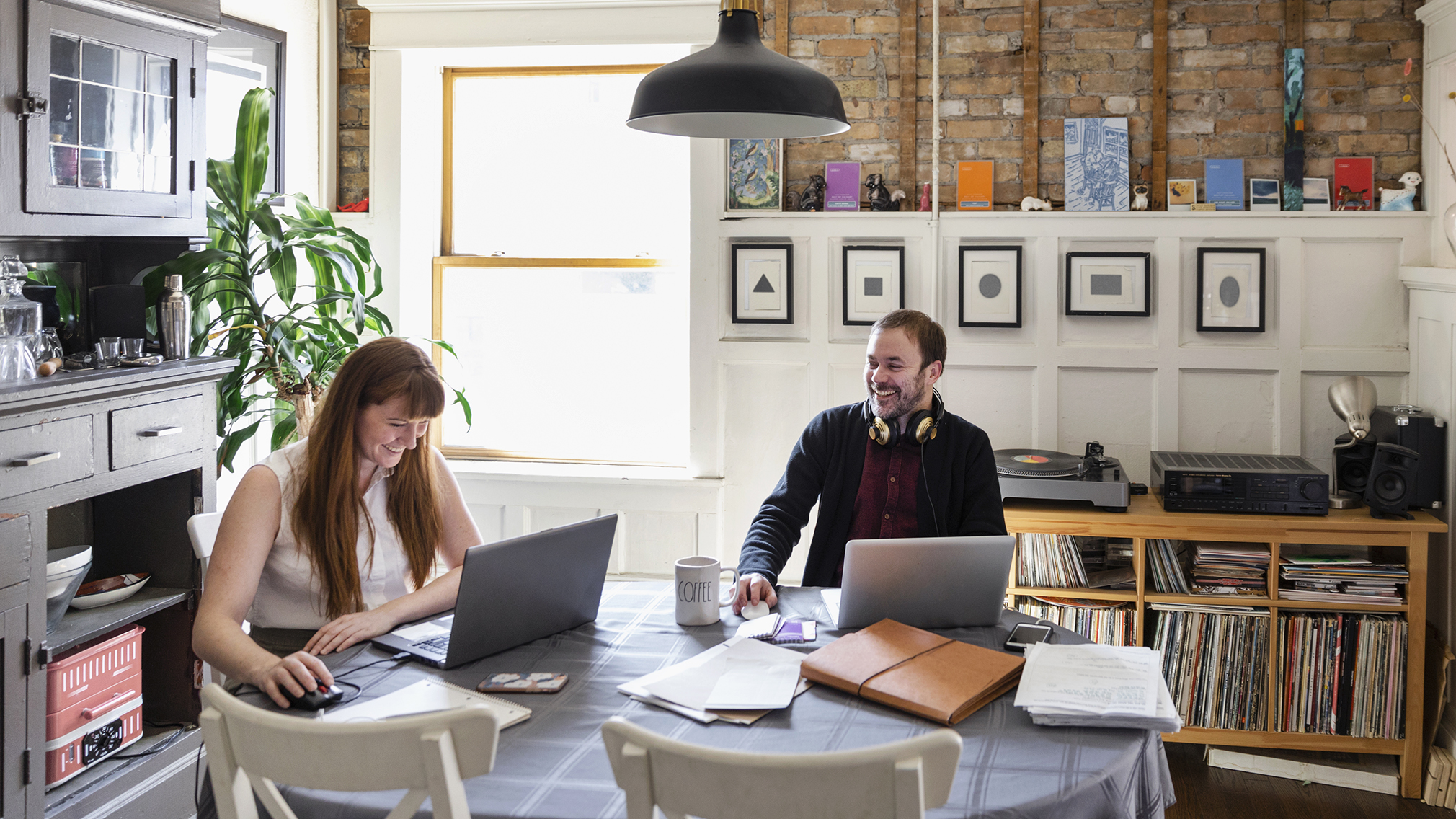How to Make a Home Budget You'll Actually Stick To
Having a budget that works for you can keep you moving toward your home-owning dreams.


Written by Susan Kelleher on September 16, 2025
Edited by Jessica Rapp
One way to think about a home budget is to view it as a map that can help keep you focused on what’s important to you. Without one, you could limit your future options by spending your way into crushing debt, or deprive yourself of joy in the moment by holding onto money too tightly.
Striking a balance that gets you where you want to be in the present and the future requires clarity around your priorities. That’s why it’s important to take a minute and think about how you want to live before you start crunching numbers.
Do you want to own a home some day? Would you rather eat ramen than give up travel or sporting events and concerts? Do you want to aggressively pay down student debt or hefty credit card balances? Or do you want to avoid sacrifices right now and make do with what you have?
There’s no right answer, just as there’s no one right way to budget. You can use a spreadsheet, an app, a worksheet or scratch pad — anything that allows you to account for the money coming in and going out. The important thing is that your budget reflects your priorities and is easy enough to manage that you’ll keep using it.
If you’re new to budgeting or have struggled with creating one in the past, try different approaches until you hit on one that works for you. The Federal Trade Commission covers the basics of making a budget, and we’ll be highlighting some approaches below. With that, let’s look at some common budgeting strategies.
1. Add up your income from all sources
If you get regular paychecks, add up the amount you take home after taxes each month, along with any other income, such as from interest on savings and investments, government assistance, alimony/palimony, child support, etc.
If you’re a contractor or freelancer, it’s helpful to take a longer view. Refer to your most recent tax return, and adjust for any new or fewer projects or assignments you expect for the current year. Once you have your total income for the year, divide it by 12 to get a monthly amount you can use to match against expenses.
Your income should be larger than your expenses every month. If your expenses are higher than your income, you’re going into debt and, if possible, you may want to adjust your spending.
2. Track your spending
Getting a handle on your spending is really important whether you’re saving for the future or responding to a sudden change in your financial circumstances. Small purchases add up, and it can be eye-opening to see where your money goes over the course of a month or a year.
Establish your main spending categories
If you use credit or debit cards to pay for most things, you can use your bank and/or credit card statements to help you track your spending, and account for it in broad categories, such as:
- shelter
- utilities
- school loans
- subscriptions
- groceries
- health expenses
- clothing
- entertainment
- transportation
You can get as detailed as you want or need to be. If you pay by cash, you can track your spending by texting yourself every time you spend money or carrying a small notebook to jot things down. If you’re using a budgeting app — and there are many — you can enter those details in the app. Budgeting apps also tend to have built in categories to help guide you.
The federal Consumer Financial Protection Bureau (CFPB) also has a spending tracker that includes some larger categories to help ensure you cover all the bases.
Account for expected recurring expenses
Once you establish the broad categories, think of things you’ve spent money on during the year, such as holidays and birthday gifts/celebrations, weddings, veterinary visits and the like. Account for those expenses, too, either in the month you expect to spend the money, or by adding them up and dividing by 12 so the expense is accounted for.
3. Save what you can every month
Taking control of your finances and putting money into savings each month — even if it’s a small amount — can provide a cushion during economic downturns and help you work toward larger goals.
Pro tip: If you’re saving to buy a home, one way to help see how much you can comfortably spend to stay in the range of affordability is to use Zillow’s BuyAbility℠ tool. The tool gives you a personalized estimate of what you can afford based on the personal financial information you provide and real-time information on the cost of borrowing the money you might need to buy a home.
Find homes in your budget with BuyAbility℠
Setting aside money every month can be as simple as scheduling automatic transfers through your credit union or bank every month. Or you can put a reminder on your calendar to sock away some money in a savings account at the same time every month so it becomes a habit.
Beyond that, this might be a good time to take a closer look at your expenses and spending habits and see where you could make some cuts. The CFPB has tips on what to do if you’re having trouble paying your bills.
4. Explore budgeting tools and approaches
Self-knowledge comes in handy here: If the work of entering details to track your spending becomes too overwhelming, your chances of sticking with it will be slim. Find a method that’s sustainable for you, and if something isn’t working, try a new method. Everyone’s brain works differently, so there’s no one-size-fits-all approach.
Here are some of the most common approaches:
50/30/20 budgeting
The 50/30/20 rule divides your income into three categories: 50% for things you need, 30% for things you want, and 20% for savings and debt repayment. The largest category, needs, is for things like housing, groceries and utilities that are essential for living. "Wants" are discretionary spending for things like concerts, electronics and games, while the 20% is for an emergency fund, a more aggressive schedule for paying down debt and retirement.
Know that one of your biggest — if not the biggest expense you have — is likely to be shelter. Experts suggest you spend no more than 30% of your income on housing. If you’re spending more than that, your housing is considered unaffordable.
70/20/10 budgeting
Similar in concept to the 50/30/20 plan except the money is allocated differently. In this method, 70% of your income goes to needs, 20% goes to savings and 10% goes to discretionary spending.
Zero-based budgeting
In zero-based budgeting, every dollar of your income is accounted for and assigned a purpose. Its name comes from the fact that when you subtract your expenses from your income, you get zero. Each month, you start from a “zero base,” which allows you some flexibility on where to spend, provided you don’t exceed your income. If you overspend in one category, you have to take it from another to maintain a zero balance.
Envelope budgeting
With envelope budgeting, you assign cash to specific spending categories, such as groceries or entertainment, and place money into physical envelopes or assign it to digital ones. When you want to spend money, you withdraw it from the assigned envelope. When the envelope is empty, that’s it for the month. This method is especially helpful if you tend to buy things on impulse.
Reverse or “pay-yourself” budgeting
This is a simple approach because it doesn’t require you to track expenses. Reverse budgeting prioritizes savings and financial goals by calling on you to set aside a portion of your income into savings immediately when you get paid, rather than tracking expenses first. Whatever is left over after you sock it away or invest it is available for bills and discretionary spending.
5. Get help from debt-management tools
Money is a major source of stress for many of us, even in the best of times. Facing a mountain of unpaid bills or a sudden loss of income can leave you feeling overwhelmed or anxious. A simple action plan that uses debt-management tools could alleviate some of that anxiety by helping you prioritize bills to ensure that expenses related to basic needs are paid first. These types of tools also allow you to track what you owe and determine if and when you can make payments.
A good place to start is your credit cards, as they often come with high interest rates. If you’re paying a high interest rate on credit card debt, think about consolidating your debt onto one with a lower interest rate.
In general, tackle what you can and remember that communicating with creditors is really important. You’re not the first person to experience financial hardship, and you won’t be the last. Communicating with creditors lets them know you’re trying, so contact them as soon as you know you’re going to have trouble making a payment.
If your needs are immediate and pressing, call 211 on your phone or access the 211 web page to connect with local resources for help with food, housing and financial assistance.
A few notes on neurodivergence
We all know that everyone’s brain is different, so what works for your best friend or co-worker might not work for you. Some common challenges noted by groups like the National Disabilities Center, the not-for-profit Neurodiversity Hub, the National Institutes of Health and others that serve neurodivergent people:
- Executive dysfunction: Some people have difficulty planning and organizing and controlling their impulses, which can make it hard to set goals, track expenses, and follow through on a budget
- Time blindness: An altered perception of time can sometimes lead to overdue bills and late fees if you tend to lose track of time. It also can make long-term financial planning feel abstract and unmanageable.
- Impulsive spending: Some people have a hard time resisting spontaneous purchases, and the immediate gratification that comes from impulse buys.
- Hyperfocus or hyper-frugality: Some may get so intensely focused on a particular purchase that they overspend, while others become overly cautious and avoid spending, which can cause anxiety.
- Emotional spending and avoidance: Financial stress can be a significant trigger for some people, leading to emotional spending as a coping mechanism or, conversely, avoiding financial tasks altogether to escape the negative feelings.
- Difficulty with sensory inputs: For autistic individuals, the barrage of visual or auditory information from financial documents or apps can be overwhelming. Similarly, those with dyscalculia may find traditional number-based budgets particularly difficult to process.
If you’re neurodivergent, you could have better success with simple systems such as following the 50/30/20 rule described above. You can also automate paying bills and savings transfers to reduce active management and use visual tools like color-coded charts or apps for easier tracking. Build flexibility into your budget with a "flex fund" or a waiting period for non-essential purchases to prevent guilt and overspending.
You also can turn saving into a challenge with clear rules and rewards, or team up with a friend to hold each other accountable and make it less tedious. If you're new to the topic of budgeting, the Neurodiversity Hub has a free guide, NDH Money Basics, that can help get you started.
Establishing a weekly routine for reviewing your finances, and breaking down complex financial tasks into smaller steps can help you from feeling overwhelmed.
Whatever approach you adopt, remember to give yourself credit for getting started and taking control of your finances.
How much home can you afford?
At Zillow Home Loans, we can pre-qualify you in as little as 5 minutes, with no impact to your credit score.
Zillow Home Loans, NMLS # 10287. Equal Housing Lender
Get pre-qualifiedHow much home can you afford?
See what's in reach with low down payment options, no hidden fees and step-by-step guidance from us at
Zillow Home Loans.
Zillow Home Loans, NMLS # 10287. Equal Housing Lender
Calculate your BuyAbility℠
Related Articles
Get a mortgage with Zillow Home Loans
Go from dreaming to owning with low down payment options, competitive rates and no hidden fees. A dedicated loan officer will guide you until you have your keys in hand.

Zillow Home Loans, NMLS #10287. Equal Housing Lender.



